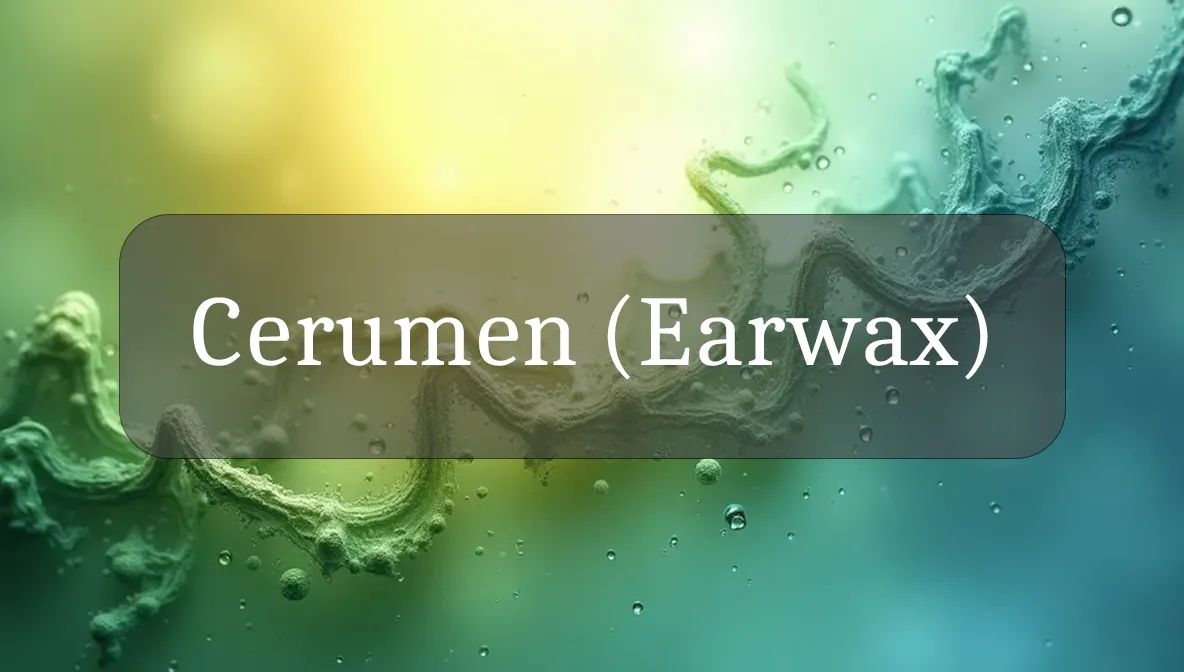Your Ear’s Natural Protector
Cerumen, more commonly known as earwax, is your body’s built-in shield for your ears. Far from being just a nuisance, this sticky substance plays a key role in keeping your ears healthy and protected. Let’s dive into what cerumen is, how it benefits your wellness, and how to care for it to support your daily health.
Identity and Function
Cerumen is a waxy, yellowish substance produced by special glands (ceruminous glands) in the outer ear canal. It’s a mix of oils, sweat, skin cells, and waxy compounds that form a protective barrier. Its main job is to trap dust, dirt, and germs before they reach your eardrum, while also keeping your ear canal moist and comfortable.
Health Benefits and Physiological Role
Earwax is like a natural bodyguard for your ears, with several important benefits:
- Protects the Ear Canal: It traps debris, bacteria, and small particles, preventing infections like swimmer’s ear (otitis externa).
- Moisturizes Skin: Cerumen keeps the delicate skin in your ear canal from drying out or cracking, reducing irritation.
- Fights Germs: It contains antimicrobial compounds that help kill bacteria and fungi, boosting your ear’s defenses.
- Self-Cleaning Mechanism: Earwax naturally moves outward as you chew or move your jaw, carrying trapped debris with it, keeping your ears clean without effort.
- Hearing Support: By keeping the ear canal clear of harmful invaders, cerumen helps maintain clear hearing.
These functions keep your ears comfortable, infection-free, and ready to hear the world around you.
Production and Sources
Your body produces cerumen naturally:
- How It’s Made: Ceruminous and sebaceous glands in the outer ear canal secrete waxy oils and sweat, which mix with dead skin cells to form earwax. Production varies based on genetics, diet, and environment.
- Dietary Influence: A balanced diet with healthy fats (like those from fish or nuts) supports the glands that produce cerumen’s oily components.
- Environmental Factors: Dusty or humid environments may increase earwax production as your body ramps up protection.
- No External Sources: You don’t consume or apply cerumen; it’s entirely made by your body.
A healthy lifestyle supports your body’s ability to produce just the right amount of earwax.
Signs of Imbalance
Too much or too little earwax can cause issues:
- Excess Cerumen (Impaction):
- Ear fullness, muffled hearing, or ringing (tinnitus).
- Ear pain, itching, or a feeling of blockage.
- Dizziness or balance issues in severe cases.
- Too Little Cerumen:
- Dry, itchy, or flaky ear canals.
- Increased risk of ear infections due to lack of protection.
- Abnormal Cerumen:
- Foul-smelling or discolored earwax (green or bloody) may signal infection or injury. If you notice hearing changes, pain, or unusual earwax, see a doctor or audiologist to check for impaction or infection.
Supporting Healthy Function
To keep your earwax working for you:
- Let It Be: Your ears are self-cleaning, so avoid over-cleaning with cotton swabs, which can push wax deeper and cause impaction.
- Clean Gently: Wipe the outer ear with a damp cloth after showering to remove excess wax without disturbing the canal.
- Stay Hydrated: Drink 8–10 cups of water daily to support healthy gland function and keep earwax at the right consistency.
- Eat Healthy Fats: Include omega-3-rich foods (salmon, walnuts) to support the oily components of cerumen.
- Protect Your Ears: Use earplugs in dusty, dirty, or watery environments (e.g., swimming) to reduce irritation and excessive wax production.
Safety and Precautions
Earwax is a natural protector, but improper handling can cause problems:
- Avoid Ear Candling: This unproven method is unsafe and can burn your ear or push wax deeper.
- Don’t Over-Clean: Inserting objects like swabs or hairpins can damage the ear canal or eardrum and lead to infections.
- Medical Conditions: Conditions like eczema or chronic ear infections may alter earwax production. Consult a doctor for management.
- Earwax Removal: If you suspect impaction, see a healthcare provider for safe removal (e.g., irrigation or suction) rather than using over-the-counter kits without guidance.
- Infections: Seek medical help if earwax is accompanied by pain, fever, or discharge, as these may indicate an infection.
If you have persistent ear discomfort or hearing issues, consult a doctor or audiologist for proper care.
Fun Fact
Did you know earwax type is genetic? Some people have “wet” earwax (soft and sticky), while others have “dry” earwax (flaky and crumbly), based on a single gene difference common in certain populations, like East Asians!
Citations
- National Institutes of Health (NIH): Earwax and Ear Canal Health.
- Mayo Clinic: Earwax Blockage and Removal.
- Cleveland Clinic: Understanding Earwax and Ear Health.
- American Academy of Otolaryngology: Earwax and Care Guidelines.
- Harvard Medical School: Earwax and Its Role in Ear Health.

